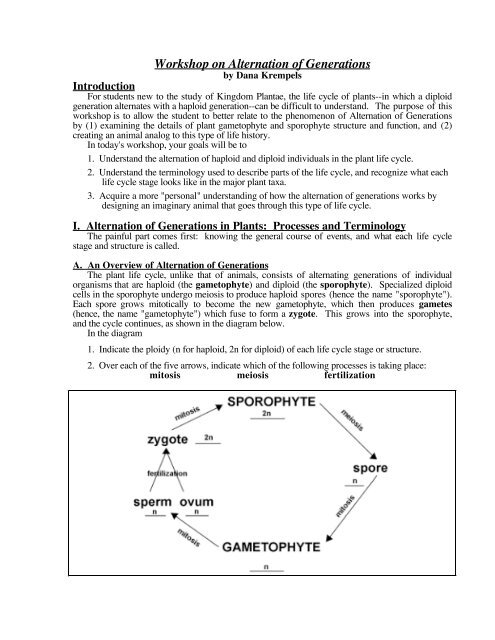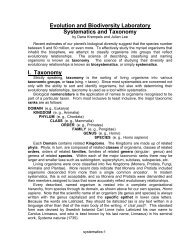Workshop on Alternation of Generations
Workshop on Alternation of Generations
Workshop on Alternation of Generations
You also want an ePaper? Increase the reach of your titles
YUMPU automatically turns print PDFs into web optimized ePapers that Google loves.
The scale-like structure riding <strong>on</strong> the female pine c<strong>on</strong>e's woody bract.d. a flowering plantThe carpel (<strong>on</strong>e to many carpels make(s) up the pistil6. A sporophyll that bears microspores is called a MICROSPOROPHYLLDescribe what this structure looks like in:a. a liverwort or mossNo true leaves, so they lack sporophyllsb. a fernSpores are bisexual; no megasporophylls are found in most species.c. a pineThe scale-like structure riding <strong>on</strong> the male pine c<strong>on</strong>e's woody bract.d. a flowering plantThe stamen8. Describe the appearance <strong>of</strong> the mature male gametophyte ina. a liverwort or mossThis is the typical liverwort plant <strong>on</strong>e usually sees; flattened thallus <strong>on</strong> the soil; Itwill eventually bear antheridia <strong>on</strong> stalklike antheridiophores.b. a fernSmall, fingernail-sized plant shaped like a little green valentine; bisexualc. a pinepollen graind. a flowering plantpollen grain9. Describe the appearance <strong>of</strong> the mature female gametophyte ina. a liverwort or mossThis is the typical liverwort plant <strong>on</strong>e usually sees; flattened thallus <strong>on</strong> the soil; Itwill eventually bear archeg<strong>on</strong>ia <strong>on</strong> stalklike archeg<strong>on</strong>iophores.b. a fernSmall, fingernail-sized plant shaped like a little green valentine; bisexualc. a pineA n<strong>on</strong>descript blob <strong>of</strong> undifferentiated cells except for an archeg<strong>on</strong>ium; found insidethe ovule (which will eventually become the seed)d. a flowering plantA coenocytic mass <strong>of</strong> cells c<strong>on</strong>taining eight nuclei, each <strong>of</strong> which has a specificfuncti<strong>on</strong>. (See diagram <strong>of</strong> the mature flowering plant's nuclei)10. In the female gametophyte, what is the name <strong>of</strong> the structure within which haploid cells developinto ova? ARCHEGONIUMDescribe what this structure looks like in:a. a liverwort or mossdifferentiated mass <strong>of</strong> cells found <strong>on</strong> the underside <strong>of</strong> the archeg<strong>on</strong>iophore inliverworts, and the upper surface <strong>of</strong> the female moss gametophyte.b. a fernPhysically resembles liverwort archeg<strong>on</strong>ium (an ovum surrounded by haploid tissueforming a "neck," with a micropyle through which sperm swim. Found at the base <strong>of</strong>the valentine-shaped gametophyte's "notch."c. a pineFound inside the undifferentiated mass <strong>of</strong> cells making up the female gametophyte,and c<strong>on</strong>sists <strong>of</strong> haploid tissue surrounding the ovum.d. a flowering plantFemale gametophyte <strong>of</strong> flowering plants lacks an archeg<strong>on</strong>ium. (Derived with respectto other plants)11. In the male gametophyte, what is the name <strong>of</strong> the structure within which haploid cells developinto sperm? ANTHERIDIUMDescribe what this structure looks like in:
Inside small bulbs, male spores (microspores) are formed, which will grow into malegametophytes.Inside larger bulbs, female spores (megaspores) are formed, which will grow int<strong>of</strong>emale gametophytes.3. Release the spores! What happens to the spores that land in an area appropriate to germinati<strong>on</strong>?Describe the resulting organism (the gametophyte generati<strong>on</strong> <strong>of</strong> this species), and again notewhether it is m<strong>on</strong>oecious or dioecious, since this will be important in the next few steps. Besure to note this animal's ploidy, and whether it has g<strong>on</strong>ads (testes and/or ovaries).Female spores landing in nice, moist areas grow mitotically into little, haploid animalsthat look like Smurfette (tm). Male spores landing <strong>on</strong> a similar substrate grow into little,haploid animals that look like the rest <strong>of</strong> the Smurfs.4. If your gametophyte is bisexual, describe how and in what anatomical locati<strong>on</strong>s it will producesperm and ova. How will sperm reach the ova? Describe the process.Mine is dioecious, so skip this part for the example. You might do this, though.5. If your gametophyte animal is male, describe how and in what anatomical locati<strong>on</strong> it will producesperm. How will these gametes reach the female gametophyte's ova? Describe the process.Oh, use your imaginati<strong>on</strong>. Those Smurfs were wearing pants, after all. (You'll neverbe able to watch that show again, you know.) They are anatomically correct little minihumanoids,and they do things just the way you'd expect them to.Except for <strong>on</strong>e thing. Like plant gametophytes, there is no intromissi<strong>on</strong> (look it up).Instead, the little Smurfs spill their seed up<strong>on</strong> the wet ground during a good rainstorm,and the sperm swim their.Once the male gametophyte releases his sperm, he shrivels up and dies.6. If your gametophyte animal is female, describe how it will produce ova, and where. Will thesegametes be released into the envir<strong>on</strong>ment, or will they remain inside the female? If they remaininside the female, describe where they will be found.Once again, this is a mini-humanoid. So use your imaginati<strong>on</strong>, and pretend thatalthough Smurfette is haploid and will produce her ova via mitosis, that the "ovaries"she has are in the expected place. As is the rest <strong>of</strong> the equipment.7. Describe fertilizati<strong>on</strong> between the male and female gametophytes <strong>of</strong> your species (if the speciesis m<strong>on</strong>oecious) or how fertilizati<strong>on</strong> takes place in your individual bisexual gametophyte (if thespecies is dioecious). What is the result <strong>of</strong> fertilizati<strong>on</strong>? Where would you find it if you wereto dissect your gametophyte animal?Sperm swim into the appropriate area, and fertilizati<strong>on</strong> takes place inside the female.If you were to dissect her, you'd find the zygote inside the little Smurfetteuterus/archeg<strong>on</strong>ium. (This is getting really disgusting.)8. What will now happen to the fertilized ovum (zygote)? Describe how it grows, and where.What happens to the gametophytes <strong>on</strong>ce fertilizati<strong>on</strong> is complete?The zygote then proceeds to grow mitotically into the new sporophyte. But sadly, like afern, this gametophyte doesn't give birth. Instead, as the zygote grows, little Smurfette isstretched and smashed out <strong>of</strong> existence.9. Describe the mature result <strong>of</strong> growth <strong>of</strong> the zygote. What will be the next step in this life cycle?The new sporophyte will again grow mitotically until mature, and then produce moremale and female spores, which will grow into Smurfs and Smurfettes.B. Thought Questi<strong>on</strong>s
1. Do any other organisms alternate haploid and diploid c<strong>on</strong>diti<strong>on</strong>s? If so, how--and at what pointin the life cycle--does this occur in each group you have named?All sexually reproducing organisms alternate haploid and diploid c<strong>on</strong>diti<strong>on</strong>s.Animals just d<strong>on</strong>'t have separate haploid and diploid individual organisms.2. What is the significance <strong>of</strong> alternating haploid and diploid c<strong>on</strong>diti<strong>on</strong>s in any organism?It allows for the recombinati<strong>on</strong> <strong>of</strong> genes, with all the evoluti<strong>on</strong>ary baggage that loads<strong>on</strong>to the scenario. (Discuss the importance to organisms <strong>of</strong> sexual reproducti<strong>on</strong>. Why doyou suppose sex exists? Wouldn't it be less risky to just reproduce asexually? What arethe risks and benefits <strong>of</strong> asexual versus sexual reproducti<strong>on</strong>?)3. How is the alternati<strong>on</strong> <strong>of</strong> haploid and diploid c<strong>on</strong>diti<strong>on</strong>s in plants different from that seen inmost other types <strong>of</strong> organisms?Only plants (and some macroalgae) have separate haploid and diploid individualorganisms.4. Are there any other organisms that have an alternati<strong>on</strong> <strong>of</strong> generati<strong>on</strong>s similar to that seen inplants? If so, what are they?Many macroalgae in the Phaeophyta and Rhodophyta exhibit alternati<strong>on</strong> <strong>of</strong>generati<strong>on</strong>s, as do some <strong>of</strong> the more derived Chlorophyta.5. If you answered "yes" to the questi<strong>on</strong>s above, how is the alternati<strong>on</strong> <strong>of</strong> generati<strong>on</strong>s in plantsdifferent from that seen in the organism(s) you named in the previous questi<strong>on</strong>?Macroalgae do not have HETEROMORPHIC alternati<strong>on</strong> <strong>of</strong> generati<strong>on</strong>s: sporophyteand gametophyte are physically indistinguishable. Their alternati<strong>on</strong> <strong>of</strong> generati<strong>on</strong>s isISOMORPHIC.6. How does the alternati<strong>on</strong> <strong>of</strong> generati<strong>on</strong>s cycle differ am<strong>on</strong>g plant taxa? How does the cyclediffer between the taxa c<strong>on</strong>sidered to be more primitive, and those c<strong>on</strong>sidered more derived?In Bryophytes, the gametophyte is the l<strong>on</strong>g-lived generati<strong>on</strong>, and the sporophyte isephemeral, living <strong>on</strong>ly a seas<strong>on</strong>. In the Tracheophytes, the situati<strong>on</strong> is reversed. In themore derived plant taxa the gametophyte is more and more reduced, with the most derivedgametophytes even lacking antheridia or archeg<strong>on</strong>ia.7. Do you believe that the alternati<strong>on</strong> <strong>of</strong> generati<strong>on</strong>s seen in plants and a few other taxa aresynapomorphic, or c<strong>on</strong>vergent? How would you test your hypothesis?A cladistic analysis <strong>of</strong> the taxa being c<strong>on</strong>sidered would yield data to support or refutethe c<strong>on</strong>tenti<strong>on</strong> that alternati<strong>on</strong> <strong>of</strong> generati<strong>on</strong>s is symplesiomorphy am<strong>on</strong>g diverse taxa.The most parsim<strong>on</strong>ious tree would indicate whether alternati<strong>on</strong> <strong>of</strong> generati<strong>on</strong>s evolved<strong>on</strong>ce or is more likely to have evolved several times and been sec<strong>on</strong>darily lost severaltimes.8. What do you suppose might be the evoluti<strong>on</strong>ary significance <strong>of</strong> a heteromorphic alternati<strong>on</strong> <strong>of</strong>generati<strong>on</strong>s?The sporophyte and gametophyte w<strong>on</strong>'t compete for resources. Also, the smallergametophyte generati<strong>on</strong> in the more derived plants is more motile, allowing for fartherdispersal from the parent sporophyte, and greater chance <strong>of</strong> outbreeding. This increaseshybrid vigor, and could c<strong>on</strong>fer a selective advantage.
















